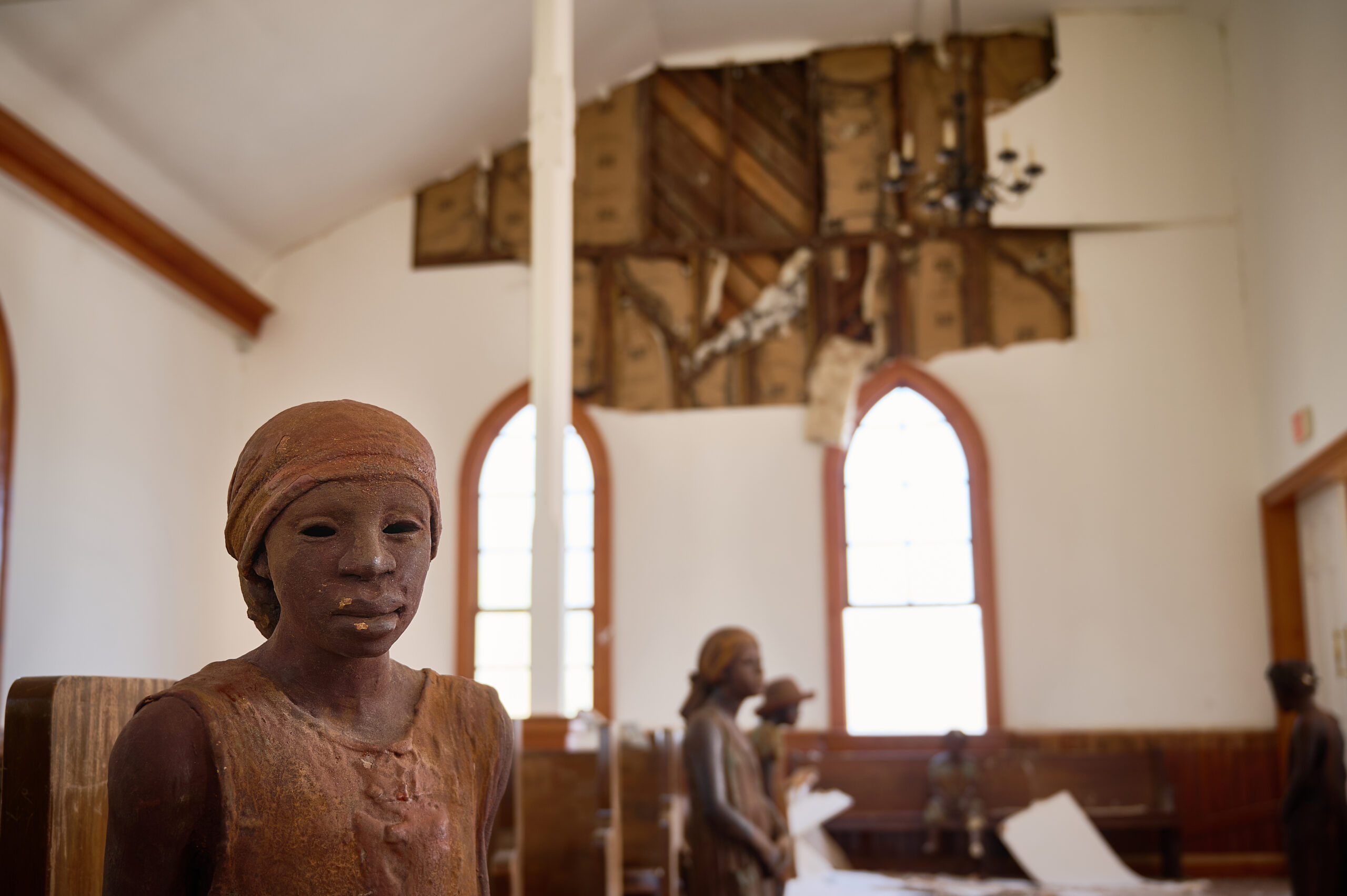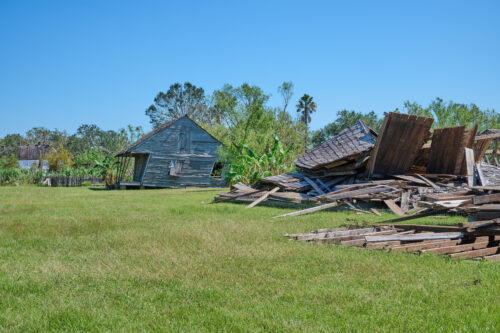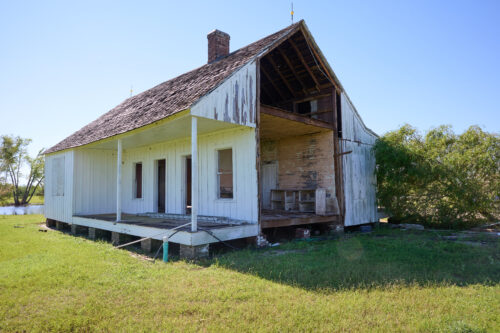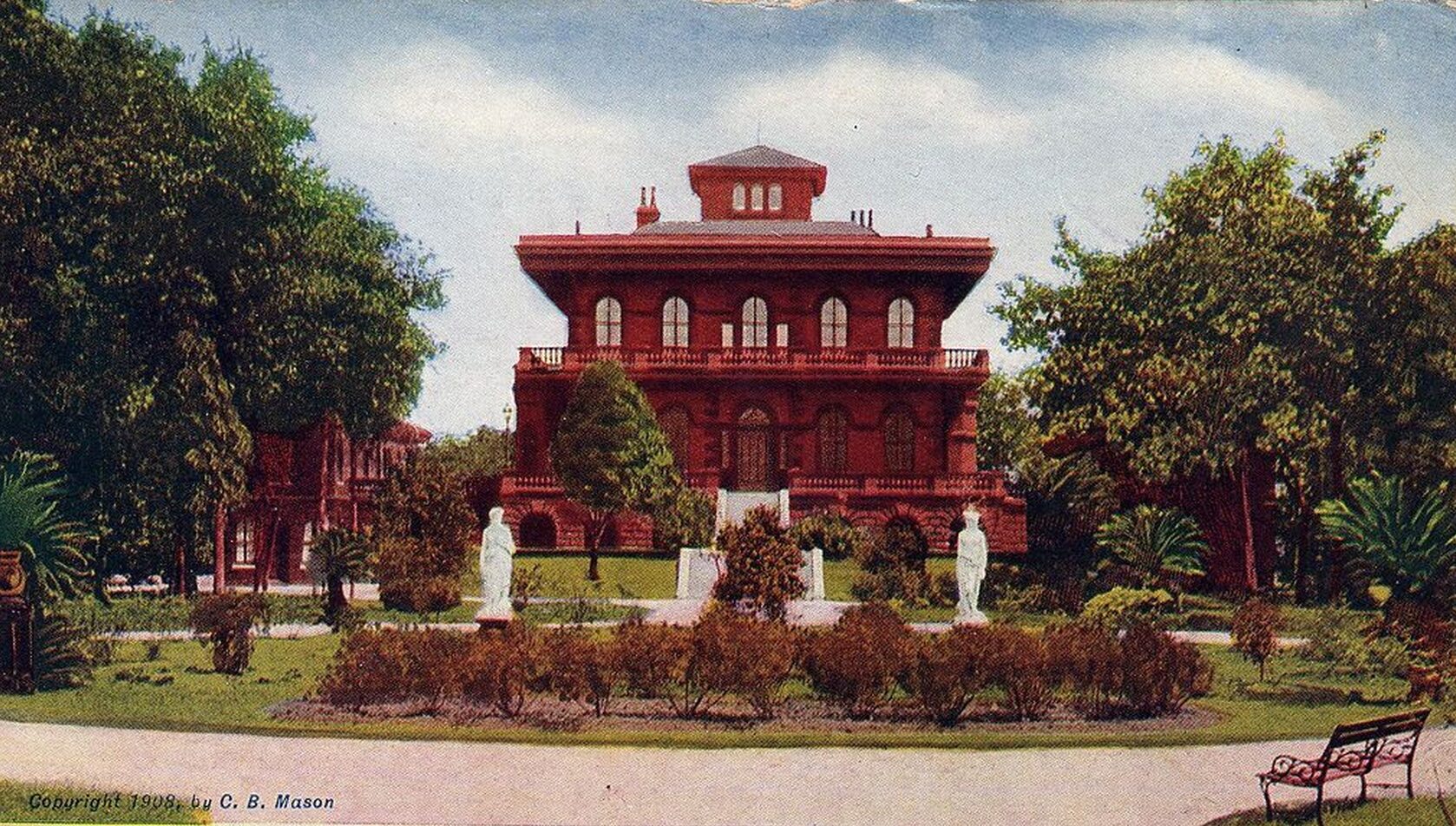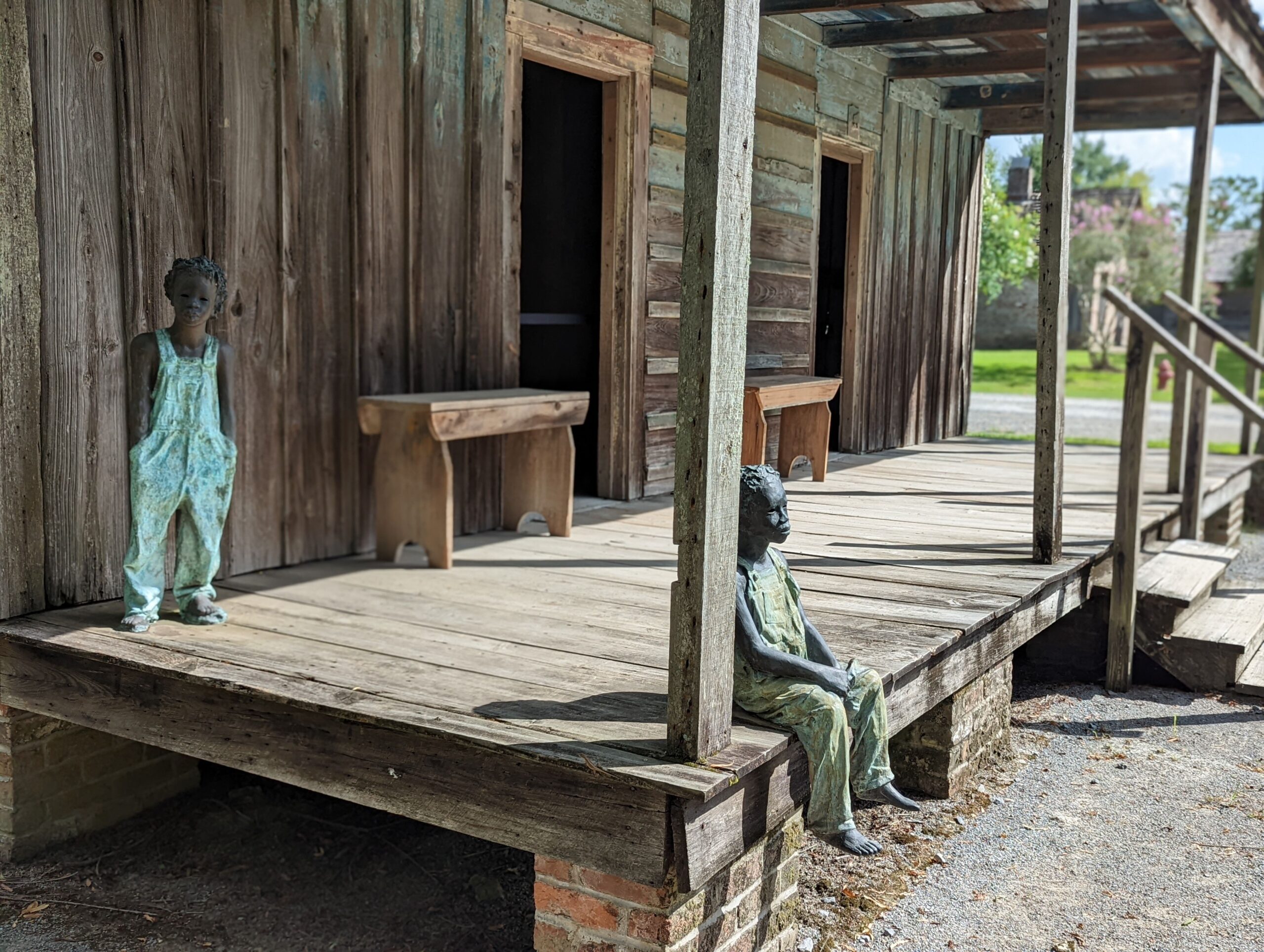This story appeared in the April/May issue of PRC’s Preservation in Print magazine. Interested in getting more preservation stories like this delivered to your door? Become a member of the PRC for a subscription!
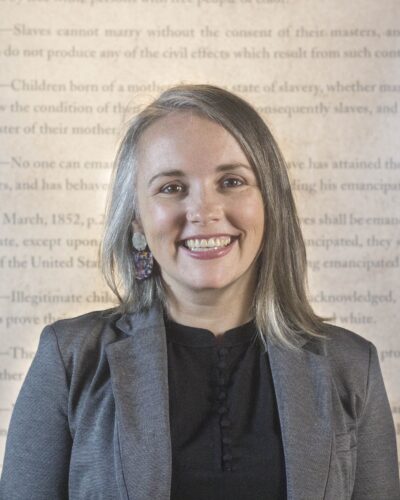 I’m a Preservationist
I’m a Preservationist
Ashley Rogers
Executive Director, Whitney Plantation
Whitney Plantation suffered terrible damage from Hurricane Ida in 2021, including the loss of historic slave dwellings. What was the extent of the damage to the whole complex of buildings and grounds and has Whitney fully recovered?
It will take years for us to fully recover. We are in the same boat that a lot of private homeowners are; that is, stretched thin, without full support of insurance, and having to make tough choices about what to repair and when. I live in New Orleans, and I’ve had a lot of visitors recently who have been shocked to see blue tarps still on homes there. I’m not shocked. We have done a great deal in the last year and a half, but the fact is that we had damage to every single building on our site, and of about 20 that saw damage, only seven were insured. Many of our buildings were just not insurable, especially those that have not yet been restored. Preservationists and insurance professionals have very different ideas about what is valuable and how to assess value. That said, I’m proud of the work we have been able to do with limited resources. Most recently, we restored the Antioch Baptist Church, a historical freedmen’s church from St. James Parish that was donated to our site. It took some of the heaviest damage from Ida, and that building alone took more than a year to repair. Today, it looks better than it did before the storm.
Advertisement
Wind damage, flooding, land loss, and the cost of insurance all are real threats faced by property owners in Louisiana. What are your biggest concerns for Whitney today?
I’m very concerned about the rising cost of insurance. Our premiums renewed in January after I had passed the budget, and I had no warning about the drastic increase in cost. From Ida in 2021 to when our policy renewed in 2022, there was only a slight increase, and that’s what I was expecting. Instead, our premium went up 160 percent, and that was not accounted for in our budget. I worry that as time goes on, premiums will keep increasing and that will become less and less affordable for us. The policies have also changed, so now our wind deductible is much higher than it had been for Ida. If Ida hit us again today — I shudder to think — we would be out of pocket much higher costs for the same repairs. That’s to say nothing of the fact that many insurers are pulling out of Louisiana entirely.
But insurance is just the tip of the iceberg, and as a person who both personally owns a historic home and also manages a large historic site, I have very serious concerns about long-term effects of climate change in our area. In particular, I worry about land loss and strengthening storms. Ida was one of the strongest storms to ever hit the U.S. and that is directly related to land loss. Storms like that now approach a Louisiana coastline that is disappearing, and with warming oceans, they sit on bathwater for hours instead of being weakened by marshes and swamps. Ida won’t be the last major storm we see that grew stronger because of land loss. In Louisiana, we live with water, but I worry that we will see more significant land loss that will cause major disruptions to our economy, to the viability of tourism, and by extension, to historic sites.
After Ida, you installed signage at Whitney to explain the harm of climate change to historic preservation. Are you incorporating that message into your interaction with visitors in other ways, too? What responses are you hearing from visitors?
Whitney Plantation’s mission is to educate the public about the history and legacies of slavery, and we firmly believe that environmental racism and issues related to climate change cannot be severed from our state’s history of slavery. The long history in Louisiana of extractive industries has led to much of the destruction of our state’s natural environment. Before oil and gas were discovered near Jennings at the turn of the 20th century, plantations changed ecosystems, destroyed swamps and burned fossil fuels. Today, chemical plants in “Cancer Alley” sit at the sites of former plantations, and the people who are most likely to bear the brunt of environmental pollution and suffer for it are descendants of enslaved people.
In addition to our signage, we participated in a national survey to gauge how museum visitors think about climate change, and we got some interesting answers. Some of our visitors definitely did not understand why we cared about climate change at all, and thought we shouldn’t talk about it — this, while we still had collapsed buildings from Ida. But I believe, and I’m supported by the board and staff, that it is part of our mission, even if visitors might not understand that yet. It’s in our mandate to help them get it.
In September 2022, for the anniversary of Ida, we held a symposium over two days called Climate & Race that explored different issues relating to the intersections of race and climate change. It was a well-attended and well-received event, and I would like to continue to do special programming like that in the future. August 29 will always be a grim anniversary for me as it is for many Louisianans, both for Ida and Katrina. I think it is important to commemorate those events in order to help to heal.
Hurricane Ida caused extensive damage to historic Whitney Plantation, which is still working to fully recover from the storm. Photos courtesy of Whitney Plantation.
How are you working to make Whitney more climate resilient — if that’s even possible? What would you like to see St. John the Baptist Parish — and the state of Louisiana — do to be more resilient?
“If that’s even possible” is the caveat of the century! We are doing our best with the resources we have, but I well know that there’s not that much we can do if we see another Category 4 or 5 storm. And that’s to say nothing of major land loss issues or flooding issues. But, that said, one thing that is certain is that the buildings that fared the best in Ida were the ones that were frequently used.
We have had to do so much restoration over the past year and a half that I basically became a construction manager. I created a new position to help with ongoing preservation work in 2022 — director of Historic Preservation and Facilities. He’s a one-man department, but I envision a future in which he has a whole crew working with him. We have been working nonstop on restoring buildings that were not yet restored when Ida hit, with the goal of opening them to the public. I firmly believe they will not see as much damage next time.
In 2022, we received an African American Cultural Heritage Fund Action Grant from the National Trust for Historic Preservation, and we are using those funds to restore the Plantation Store, which will help us interpret the Jim Crow history of the site. We hope to open that building in 2024. We are also working, slowly, on the restoration of the Mialaret Plantation Big House, which was historically Whitney’s neighboring plantation but became part of the property in 1920. We intend to use that building for office space.
In addition to restorations, we are just beginning to work on emergency planning. The Louisiana Endowment for the Humanities has opened up a grant for emergency planning that we intend to apply for. And it may be a small effort, but we also just got rid of plastic water bottles in the Visitor Center. There is no commercial recycling in St. John Parish. (There’s something I’d like to see change.) So, our visitors have been buying plastic water bottles for eight years and throwing them in the trash, which feels really hypocritical and counter to our values. We still can’t recycle, but we have switched to boxed water.
For St. John, and for the state of Louisiana, I really wish we would stop imagining that petrochemical companies and heavy industry are the only means of economic development. I would like to see Louisiana take environmentalism more seriously and work to reign in companies that pollute our air and water.
For those of us who care deeply about protecting Louisiana’s cultural heritage sites, including Whitney, what can we do to help?
Donate! Historic sites like ours are struggling with the costs associated with preservation and upkeep, and every time we get a general donation to help with operating costs, it’s a big relief for me. I also think people can get politically involved and talk to their representatives about what they’re doing to help historic sites in their area. We need grant opportunities and assistance that we very rarely get from state and local governments. I would also say, supporting preservation and humanities organizations is really helpful. The Louisiana Endowment for the Humanities has been a lifeline for us over the past few years, and they underwrote our Climate & Race seminar as well as provided emergency funding in the wake of Ida. They do great work for sites like ours with limited resources.
Visit whitneyplantation.org to learn more
Advertisements



